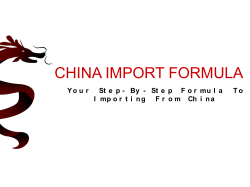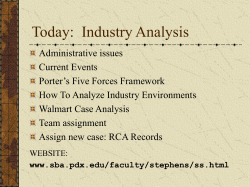
Extra dimensions to portfolio analysis
Extra dimensions to portfolio analysis
Dirk-Jan F. Kamann
NEVI-Chair Purchasing Management, University of Groningen, Faculty of Management &
Organisation, Scientific Director Groningen Research Institute of Purchasing (GRIP), E-Mail:
d.j.f.kamann@bdk.rug.nl,
www.GripOnPurchasing.com
Address:
Prof. Dr. Dirk-Jan F. Kamann,
GRIP, Faculty of Management of Management & Organisation,
P.O. Box 800,
NL-9700 AV Groningen,
The Netherlands
Tel: +31.50.363 3373
Fax: +31.50.318 6900
GSM: +31.6.212.55.334
1
Extra dimensions to portfolio analysis
Extended abstract
This contribution starts with a discussion of various types of portfolios existing in literature. It then
combines the buyer’s view, the seller’ view and the complexity of the product. This results in a cube.
As an example, one test case is provided to show the relevance and application of the cube. The
paper goes on with adding the potential of E-Business (both E-Commerce and E-Porcurement) and
the effects on the networks, the type of roles actors will play in the new situation a d the type of actors
that will play these roles. This paper has been presented as a poster session at the IPSERA meeting
in 1999 in London (Ontario). The concepts developed have since been tested on several companies.
The paper follows the following line of arguments.
1. The classical portfolio matrix: the Kraljic matrix
financial relevance
The portfolio matrix (Kraljic, 1983) is a useful tool to classify purchased goods and the suppliers
involved. Taking the complexity of the supplier market and the financial relevance or impact into
account, goods and suppliers can be classified as leverage, routine, strategic and bottleneck items.
The strength of the instrument is that it enables the purchaser to
differentiate between the various supplier relations and strategies that
high
are appropriate for each category. These are
• leverage items: hard bargaining, induce services
• routine items: reduce handling/overhead costs; try to cluster into
leverage
strategic
leverage contracts
• strategic items: go for partnerships
• bottleneck items: ensure supply
Although being useful, the portfolio method does not take the supplier's
perspective into account. This dimension is covered by the matrix
described by Hugh et. al (1998).
routine
bottleneck
low
complexity of supply market
many suppliers
1 supplier
2. The buyers market from the supplier's perspective
amount of buyers from the supplier's
perspective
Using the complexity of the supply market (in practice: are there many or
few suppliers) and the complexity of the buyer market (many or few buyers
for that item) we find:
• generic items (standardized commodities)
• tailorized items, produced through flexible technology (mass
customization)
• propriatary products (brand names like Microsoft etc., up to very
recently products from Semi-State companies like energy, telecom and
mail fell into this category)
• custom design: the real one-to-one relations
many
generic
tailorized
proprietary
custom
design
few
Generic and proprietary items come with standard specs. For tailorized
items, some customization can take place, within certain restrictions.
Custom design includes the design and development stage of items.
amount of suppliers
many
few
many buyers
Combining the two matrices results in a cube reflecting both
the complexity of the supplier market (from the purchasing
perspective) and the buyer market (from the vendor's
perspective).
Combining the matrices makes us aware that part of the
strategic and bottleneck items belongs to the proprietary
column: 1 monopolistic supplier (or very few oligopolistic
1 buyer
high
financial relevance
3. The result: the Cube
generic
complexity of the buyer market
tailorized
proprietary
custom
design
leverage
strategic
routine
bottleneck
low
complexity of supplier market
many suppliers
2
1 supplier
suppliers) and many buyers. The change of getting adapted product specifications are very small. For
many items in this column, most (smaller) buyers do not deal directly with the producer, but with
agents.
4. Dealing with complexity of the product : the Fisher Matrix
high
financial relevance
We find that many companies differentiate between various types of
leverage items in their supplier strategy. based on the complexity of the
leverage
strategic
product. A food multinational for instance differentiates between standard
"simple" products like potatoes and more complex products like complete
meals. For the more complex products, value analysis is applied to
standardize items across markets and producers. To do this successfully, all
routine
bottleneck
stakeholders involved – or at least their interests - have to be included in the
'standardization' team that performs the analysis: producers, transporters,
low
packagers, printers, retailers, marketing department, new product
complexity of product
development, finance. In practice, a group size of 8 still is workable. Since
low
high
this value analysis/value engineering is performed with all relevant actors in
the chain or network, we use the name Joint Value Analysis. In literature,
Fisher already in 1970 describes the role of complexity of the product. His matrix and criteria used in
the contribution actually looks very similar to the Kraljic contribution of 1983. JVA has two stages:
1. the initial stage where the actual JVA takes place, resulting in a proposal for Joint Value
Engineering of all activities and goods in the chain;
2. the ordering process once the new product and services of all involved has been established. This
second phase bears close resemblance with 'normal' leverage items
5. The Cube with Joint Value Analysis (JVA)
6. The role of E-Contacts: 'Blue products'
generic
JVA
leverage
strategic
tailorized
proprietary
custom
design
bottleneck
1 buyer
high
financial impact on resources
From observations of companies, we deducted that Joint Value
Analysis (JVA) is not performed with generic products, nor with
proprietary products. Suppliers of these products may be willing to
adopt JVA on the logistics involved, but not on the product per se. As
said before, very simple products are usually not subject to JVA,
while extremely complex products usually fall into the custom design
category. Therefore, JVA should be place in the transcending border
area between leverage items and strategic items. Of course, the line
shown is an analytical one and differs between companies. The
resulting cube should be seen as an analytical tool to assist supplier
strategies.
many buyers
complexity of buyer market
routine
low
complexity of the supplier market
many suppliers
1 supplier
complexity of the product
low
high
Why did we colour three columns in our cube blue? The reason is that these blue goods can be very
well integrated in ordering and procurement systems using E-Contacts (EDI, E-procurement, Ebusiness etc.). Custom design uses E-mail but requires many face-to-face contacts. Therefore, the
contents of the relations differ. What about the red column of JVA? This differs between the two JVA
stages: (1) in the first stage many face-to-face contacts are required, similar to custom developers
(2) the ordering process of the second phase is open for EDI and other electronic systems.
7. New roles, new actors
Extrapolating our findings above, we sense new roles for new types of actors. These new actors are:
• brokers, potentially virtual organisations that just redistribute orders, organise and collect leverage
buying power combined with spot buying on Internet; they organise the logistics from producers or
warehouses to the buyers, including 'ship on line', 'vendor managed inventory' etc. After approval
of the catalogue, ordering is decentralised to authorized users in the buyer's organization
• capacity suppliers: they actually produce goods and services. Buyers – either the brokers or direct
buyers - reserve slot time in the production line. In for instance week 42, day xx, yy hours is
reserved for production for client zz.
• co-developers: these are actors for design and development where much face-to-face contact and
long-term (personal) relationships are important. Once a product has been developed, actual
production can be done by capacity suppliers, either at component level or modular level while
even final assembly can be outsourced to a capacity supplier.
3
Logistics is the glue that bonds the business processes of the three categories of actors. Within the
category 'logistics', again we see brokers, capacity suppliers ('wheels') and co-developers designing
total logistical solutions.
virtual organisation
digital E-contacts
brokers
logistics
capacity
suppliers
in-house production
co-developers
face-to-face contacts
4
8. The new network
The network of the new actors is a configuration around a focal firm with:
•
•
•
brokers, connected to capacity suppliers (of generic and proprietary goods) and some
tailorizing suppliers. They also organise the logistics involved. Brokers actually can be
suppliers and buyers.
capacity suppliers of goods, services (including logistics)
co-developers
Behind each actor in the network we can imagine another 'balloon set'. That means that
instead of the 'simple' supply chain we now have an enormous balloon festival to cover all
actors in some way relevant for our performance. Some of the relationships in the festival are
relatively stable, some are rather loose. It doesn't make life easier for the average purchasing
manager...
capacity suppliers:
brokers
co-developers
tailorized products
generic- and proprietary products
References:
Fisher, L. (1970), Industrial marketing: an analytical approach to planning and
execution, Princeton: Brandon/Systems Press
Fisher, B.A. (1973), Small group decision making: communication and the group
process, New York: McGraw-Hill
Hughes, J., M. Ralph and B. Michels (1998), Transform your supply chain: releasing
value in business, London: International Thomson Press, pp. 53.
Kamann (1999), Purchasing from a network perspective, Groningen: Charlotte
Heymanns Publishers (in Dutch);
Kamann (2000) "An extra dimension to Kraljic”, Tijdschrift voor Inkoop en Logistiek,
April, vol. 4. pp. 8-12,(in Dutch)
Kraljic, P. (1983), “Purchasing must become supply management”, Harvard Business
Review, September-October, pp. 109-117.
5
© Copyright 2025









